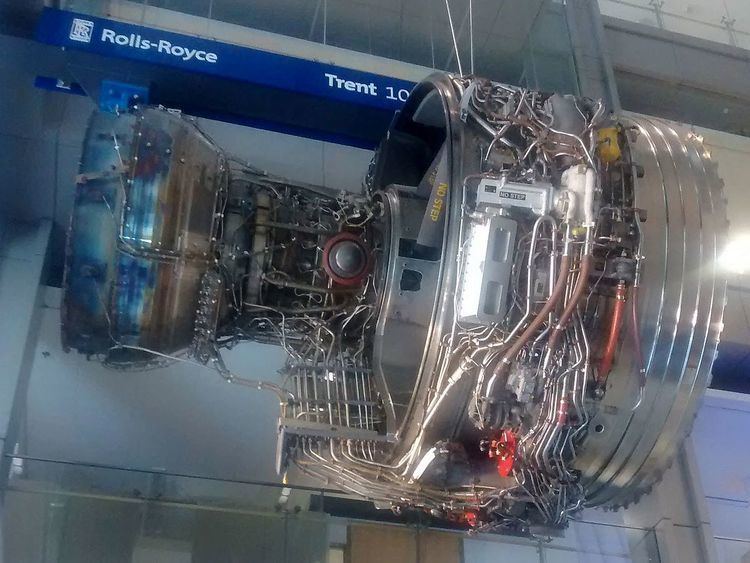 | ||
The Rolls-Royce Trent 1000 is a British turbofan engine, developed from earlier Trent series engines. The Trent 1000 powered the Boeing 787 Dreamliner on its maiden flight, and on its first commercial flight.
Contents
Design and development
On 6 April 2004 Boeing announced that it had selected two engine partners for its new 787: Rolls-Royce and General Electric (GE). Initially, Boeing toyed with the idea of sole sourcing the powerplant for the 787, with GE being the most likely candidate. However, potential customers demanded choices and Boeing relented. For the first time in commercial aviation, both engine types will have a standard interface with the aircraft, allowing any 787 to be fitted with either a GE or Rolls-Royce engine at any time as long as the pylon is also modified.
As with earlier variants of the Trent family, Rolls partnered with risk and revenue sharing partners on the Trent 1000 program. This time there were six partners: Kawasaki Heavy Industries (intermediate compressor module), Mitsubishi Heavy Industries (combustor and low pressure turbine blades), Industria de Turbo Propulsores (low pressure turbine), Carlton Forge Works (fan case), Hamilton Sundstrand (gearbox) and Goodrich Corporation (engine control system). Altogether, these partners have a 35 percent stake in the program.
In June 2004, the first public engine selection was made by Air New Zealand who chose the Trent 1000 for its two firm orders. In the largest 787 order, that of Japan's All Nippon Airways, Rolls-Royce was selected as the engine supplier on 13 October 2004. The deal is valued at $1bn (£560m) and covers 30 787-3s and 20 787-8s. The Trent 1000 will be the launch engine on both currently planned 787 models, the -8 with ANA and the -9 with Air New Zealand. On 7 July 2007, Rolls Royce secured its largest ever order from an aircraft leasing company when ILFC placed an order worth $1.3 billion at list prices for Trent 1000s to power 40 of the 787s which it has on order(~ $16.25 m per engine, which is ~ 22% of airplane price), and on 27 September 2007 British Airways announced the selection of the Trent 1000 to power 24 Boeing 787 aircraft. Trent 1000's share of the 787 engine market was 40% at the end of August 2008.
The Trent 1000 family makes extensive use of technology derived from the Trent 8104 demonstrator. In order to fulfill Boeing's requirement for a "more-electric" engine, the Trent 1000 is a bleedless design, with power take-off from the intermediate-pressure (IP) spool instead of the high-pressure (HP) spool found in other members of the Trent family. A 2.8 m (110 in) diameter swept-back fan, with a smaller diameter hub to help maximize airflow, was specified. The bypass ratio has been increased over previous variants by suitable adjustments to the core flow. A high pressure ratio along with contra-rotating the IP and HP spools improves efficiency, and the use of more legacy components reduces the parts count to minimise maintenance costs. A tiled combustor is featured.
The first run of the Trent 1000 was on 14 February 2006, with first flight on Rolls-Royce's own flying testbed (a modified Boeing 747-200) successfully performed on 18 June 2007 from TSTC Waco Airport. The engine received joint certification from the FAA and EASA on 7 August 2007 (7-8-7 in the UK). The initial design failed to meet the Boeing required specific fuel consumption (SFC). However, entry into service has been repeatedly delayed, following a series of setbacks to the Boeing 787 airframe programme, allowing two redesign packages to be incorporated into the test programme which are said to improve the SFC by 3-4% to bring it to within 1% of specification. On 2 August 2010, a Trent 1000 suffered an uncontained intermediate turbine failure on a test stand, reported as being due to a fire in the engine oil system. On 26 October 2011, the 787 flew its first commercial flight from Tokyo-Narita to Hong Kong on All Nippon Airways, powered by Trent 1000 engines.
Trent 1000 TEN
Rolls-Royce developed an improved version of the Trent 1000, which achieves reduced fuel burn via an improved intermediate pressure compressor, in which the aft (rear) stages spin at higher speeds; three blade blisks were introduced in the new compressor. Rolls-Royce claims that the new design is helping the company reduce General Electric's dominance of the Boeing 787 engine market, with 42% of newly declared engine orders now going to Rolls. It was certified by the EASA in July 2016. Claiming to offer up to 3% lower fuel burn than the competition, it first flew on a Boeing 787 on 7 December 2016.
Applications
Variants
Variants were certified by the EASA
Specifications
Data from EASA
